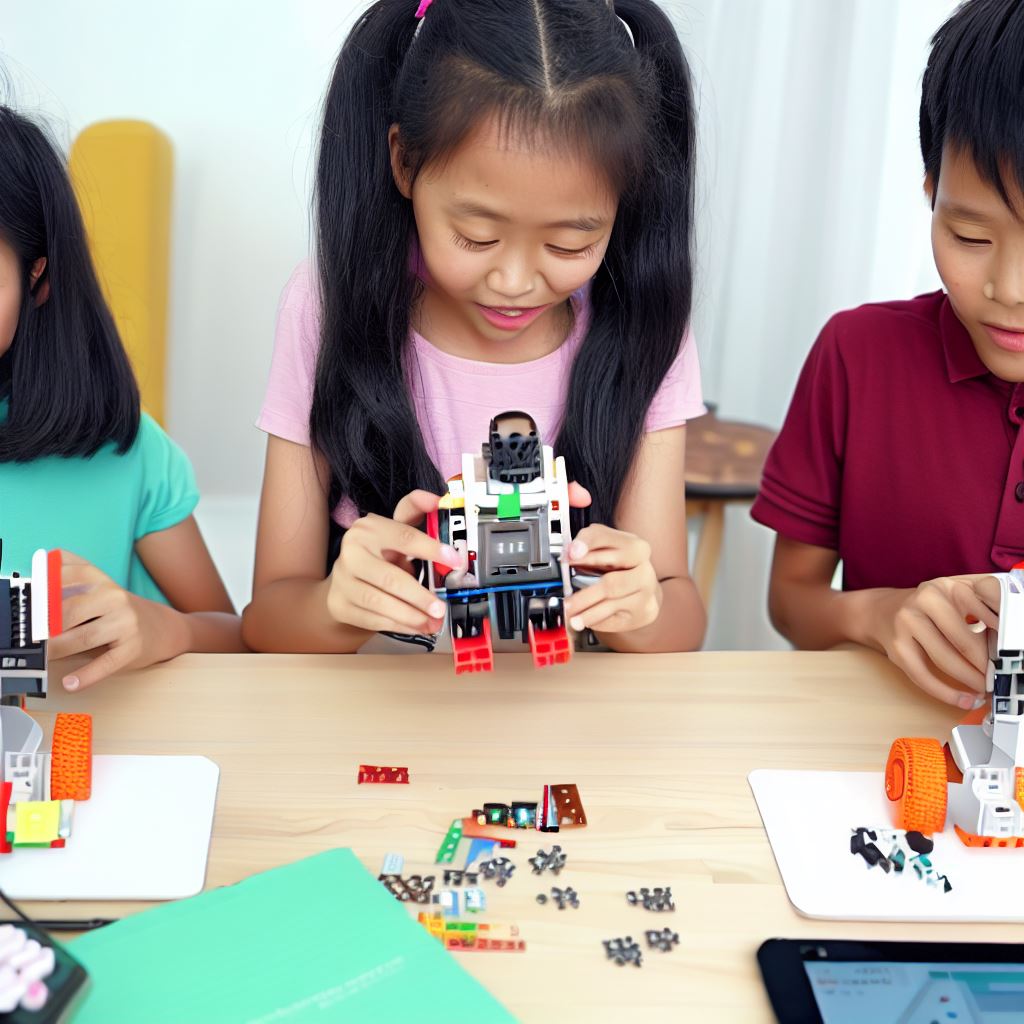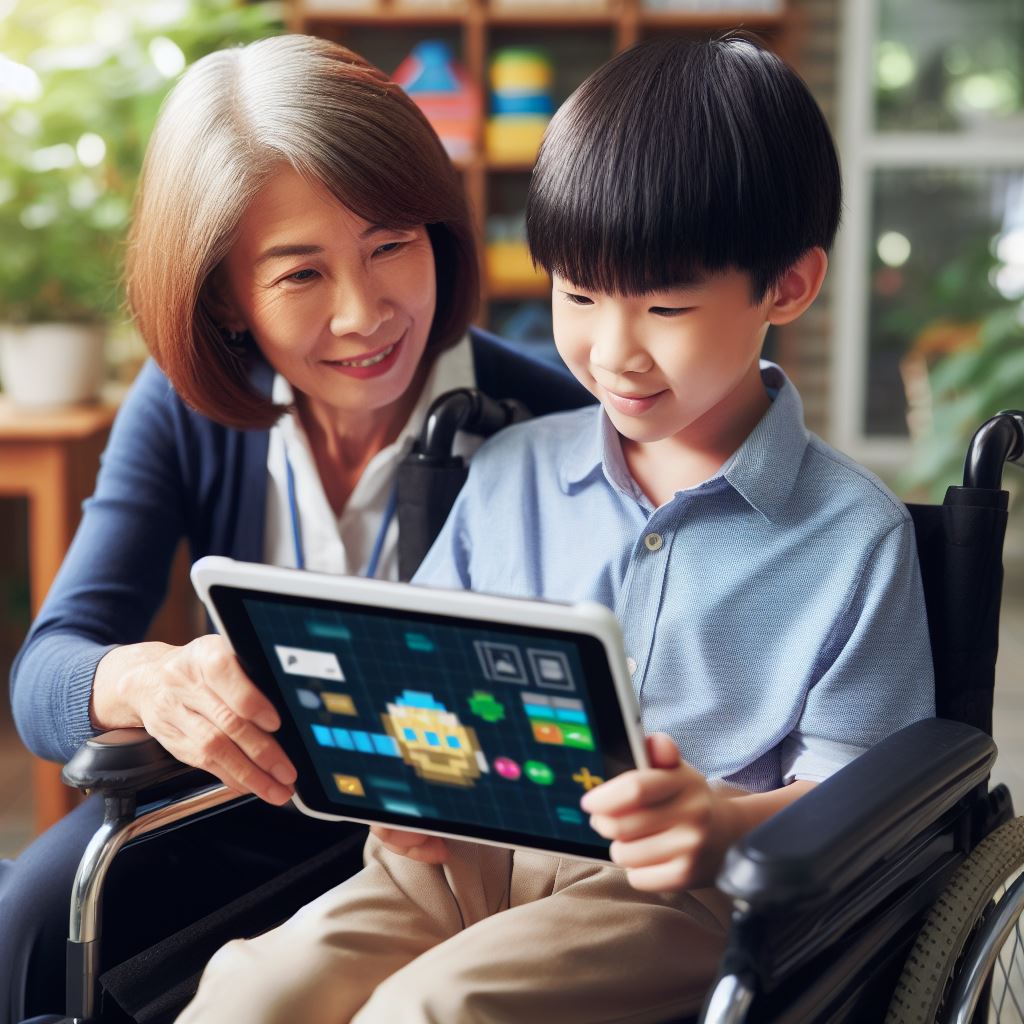Introduction
In today’s digital age, introducing kids to robotics through coding classes is not just a trend but a crucial educational initiative.
Children are growing up surrounded by technology, making it vital to equip them with the skills they need to navigate and shape their future.
This blog post will delve into the importance of these classes, shedding light on how they empower kids to become innovative problem solvers.
We will explore how robotics and coding enhance critical thinking, creativity, and teamwork skills, setting the foundation for success.
Through hands-on experiences, young learners not only understand the mechanics of machines but also gain a deep appreciation for STEM fields.
Furthermore, we will discuss how robotics and coding classes foster adaptability, preparing kids for a rapidly changing job market.
We’ll also delve into the role of robotics in making learning more engaging and memorable, sparking curiosity and passion.
Stay tuned as we delve deeper into these exciting topics, providing insights into the world of robotics and coding for kids!
Benefits of teaching robotics and coding to kids
Introducing kids to robotics and coding classes is a valuable way to enhance their skills and abilities. Let’s explore the benefits.
Development of critical thinking and problem-solving skills
- Robotics and coding require kids to think critically and find solutions to various challenges.
- By engaging in this process, children develop problem-solving skills that are essential in their lives.
- They learn to analyze situations, break them down into smaller parts, and find logical solutions.
- These skills transfer to other areas of their lives, helping them to tackle complex problems effectively.
Boost in creativity and innovation
- Robotics and coding classes provide a platform for kids to express their creativity.
- They can bring their imaginative ideas to life through designing and programming robots.
- By experimenting with different codes and algorithms, they learn to create innovative projects.
- This fosters their curiosity and nurtures their ability to think outside the box.
Improvement in logical reasoning and analytical skills
- Learning robotics and coding involves understanding logical sequences and algorithms.
- As kids engage in coding exercises, their logical reasoning skills improve significantly.
- They learn to identify patterns, make connections, and analyze data to solve problems.
- These analytical skills are crucial for their academic and professional growth.
Overall, teaching kids robotics and coding has numerous benefits that extend beyond technical knowledge.
It equips them with essential skills such as critical thinking, problem-solving, creativity, and logical reasoning.
These skills empower children to face challenges, adapt to technological advancements, and succeed in the digital age.
Moreover, robotics and coding classes provide a fun and engaging learning environment for kids.
They learn through hands-on activities, collaborating with peers, and exploring various concepts.
By developing a passion for robotics and coding, kids become inspired to pursue STEM-related fields in the future.
Tech Consulting Tailored to Your Coding Journey
Get expert guidance in coding with a personalized consultation. Receive unique, actionable insights delivered in 1-3 business days.
Get StartedParents and educators should encourage their children to attend robotics and coding classes to unlock their potential.
These classes serve as a foundation for children to acquire critical skills that will benefit them throughout their lives.
Investing in their education today will prepare them for the challenges and opportunities of tomorrow.
Read: Coding Games for Kids: Learning Can Be Fun!
Introducing coding classes for kids
Overview of Coding Classes Specifically Designed for Kids
Coding classes for kids are educational programs that teach children the fundamentals of programming.
These classes are tailored to suit the learning capabilities and interests of young children.
They aim to make coding fun and engaging for kids through interactive activities and projects.
By using age-appropriate teaching techniques, coding classes ensure effective learning outcomes.
Through these courses, children learn logic, problem-solving skills, and how to apply them in real-life situations.
Most coding classes for kids focus on integrating coding with robotics to enhance the learning experience.
This combination allows kids to see the practical results of their coding efforts through robot interactions.
Importance of Starting at an Early Age
- Introducing coding classes to kids at an early age helps them develop essential skill sets.
- Coding enhances logical reasoning, critical thinking, creativity, and perseverance in young minds.
- Starting early allows kids to familiarize themselves with technology and better adapt to the digital era.
- By learning coding concepts early, children gain an advantage in future academic and career pursuits.
- Early exposure to coding also encourages an interest in STEM subjects, leading to a wider range of future opportunities.
Introduction to Various Coding Platforms and Tools Suitable for Kids
- Scratch: Scratch is a block-based programming language designed to introduce kids to coding. Scratch allows children to create interactive stories, games, and animations using drag-and-drop coding blocks.
- LEGO Mindstorms: LEGO Mindstorms combines LEGO building elements with coding to create robots. With LEGO Mindstorms, kids can build and program robots to perform specific tasks using a coding interface.
- Python: Although usually regarded as a professional language, Python has simplified versions for kids. Python platforms like “Turtle Graphics” provide a visual way for children to learn coding concepts.
- Roblox Studio: Roblox Studio enables kids to create their own games and learn Lua programming. By designing and coding their own games, children develop problem-solving and game development skills.
- Arduino: Arduino is an open-source platform that introduces kids to electronics and coding. With Arduino, children can build projects like robotic arms, smart home devices, and more.
Basically, coding classes specifically designed for kids play a crucial role in introducing them to robotics and programming concepts.
Starting at an early age helps children develop essential skills and prepares them for a technology-driven future.
Various coding platforms and tools, such as Scratch, LEGO Mindstorms, Python, Roblox Studio, and Arduino, offer interactive and age-appropriate learning experiences for kids.
Build Your Vision, Perfectly Tailored
Get a custom-built website or application that matches your vision and needs. Stand out from the crowd with a solution designed just for you—professional, scalable, and seamless.
Get StartedBy encouraging children to explore the world of coding, we empower them to become creators and problem solvers in the digital age.
Read: Teaching Kids to Code: Do’s and Don’ts for Parents
Integrating Robotics with Coding Classes
Integrating robotics with coding classes is a fantastic way to engage kids in STEM education.
By combining the hands-on experience of building and programming robots with the logic and problem-solving skills of coding, children can develop a deeper understanding of technology and its applications.
Robotics and its Connection to Coding
Robotics is a multidisciplinary field that involves the design, construction, and programming of robots.
It combines elements of computer science, engineering, mathematics, and physics.
Coding, on the other hand, is the process of creating instructions for computers and robots to follow.
It allows developers to control the behavior and functionality of robotic systems.
Overview of Different Robotics Kits and Tools Suitable for Kids
There are several robotics kits and tools available specifically designed for kids to introduce them to the world of robotics and coding:
- LEGO Mindstorms: This popular kit allows children to build and program their own robots using LEGO bricks and a visual programming interface.
- Sphero: Sphero offers robotic balls that can be programmed using a mobile app, providing an interactive and playful learning experience.
- Arduino: Arduino is an open-source platform that includes a microcontroller board and software, enabling kids to create and control their own robotic projects.
- Ozobot: Ozobot is a small robot that can follow lines and codes drawn on paper or screens, introducing children to basic programming concepts.
How Robotics Enhances the Learning Experience of Coding Classes
Introducing robotics in coding classes offers several benefits for young learners:
- Hands-on Learning: Building and programming robots provide a hands-on experience that reinforces coding concepts and helps children grasp abstract concepts more easily.
- Problem-solving Skills: Robotics challenges students to think critically, logically, and creatively, fostering problem-solving abilities that are essential in coding and real-world scenarios.
- Collaboration: Robotics projects often require teamwork and collaboration, teaching children effective communication, cooperation, and division of labor.
- Applicable Knowledge: By working on tangible projects, kids can see how coding can be applied to control physical objects, making the learning process more relevant and engaging.
- Motivation and Engagement: The excitement of building and programming robots can spark children’s curiosity and motivation to explore further, ensuring a more enjoyable learning experience.
Integrating robotics with coding classes opens up a world of possibilities for young learners.
Not only does it introduce them to cutting-edge technology, but it also nurtures essential skills such as problem-solving, teamwork, and creativity.
By making STEM education interactive and fun, we can inspire the next generation of innovators and problem solvers.
Read: Is Coding for Kids Just a Trend or a Necessary Skill?
Optimize Your Profile, Get Noticed
Make your resume and LinkedIn stand out to employers with a profile that highlights your technical skills and project experience. Elevate your career with a polished and professional presence.
Get Noticed
Curriculum and Activities in Coding Classes for Kids
Introducing kids to robotics and coding classes can be an exciting and educational experience.
These classes create a fun environment for children to learn and develop their skills in programming, problem-solving, and logical thinking.
Let’s take a closer look at the curriculum and activities in coding classes for kids:
Overview of a Typical Curriculum for Coding Classes for Kids
A typical curriculum for coding classes for kids includes various modules that progressively introduce them to coding languages and concepts.
The curriculum is designed to make the learning process interactive and engaging. Here’s a breakdown of the modules taught:
- Introduction to Coding: Kids learn the basics of coding, such as algorithmic thinking and sequencing.
- Block-Based Coding: They explore block-based coding languages like Scratch, where they can create animations and games by dragging and dropping code blocks.
- Text-Based Coding: As children grasp fundamental coding concepts, they transition to text-based languages like Python or JavaScript.
- Web Development: Kids are introduced to HTML, CSS, and web development, where they can create their own websites.
- Robotics and Hardware: Students get hands-on experience with robotics kits, learning how to program robots to perform specific tasks.
- App Development: This module teaches kids how to build simple mobile applications using platforms like MIT App Inventor.
Introduction to Coding Languages and Concepts Taught
Coding classes for kids focus on teaching coding languages and concepts that lay the foundation for their future learning. Some of the languages and concepts covered include:
- Sequencing and Loops: Kids learn how to give instructions in a specific sequence and create loops to repeat tasks.
- Conditionals and Variables: They understand how to use conditionals to make decisions and variables to store and manipulate data.
- Functions and Events: Children explore the concept of functions to create reusable pieces of code, and events to trigger specific actions.
- Object-Oriented Programming: As children progress, they learn about object-oriented programming and how to design and create their own objects.
Hands-On Activities and Projects to Engage Kids in the Learning Process
Coding classes for kids are enriched with hands-on activities and projects that make learning coding more exciting.
These activities help children apply their coding skills and foster creativity. Here are some examples of hands-on activities and projects:
- Creating Animations: Kids can create their own animated stories or characters using block-based coding languages.
- Building Games: They have the opportunity to design and build their own interactive games, improving their problem-solving skills.
- Programming Robots: Children get to program robots to solve challenges, teaching them logical thinking and critical problem-solving.
- Developing Apps: Kids can design and develop simple apps, bringing their ideas to life and enhancing their communication skills.
- Website Design: Children learn how to build their own web pages and showcase their creativity through web development projects.
Generally, coding classes for kids offer a comprehensive curriculum that introduces them to coding languages, concepts, and hands-on activities.
These classes not only teach children valuable skills but also foster creativity, logical thinking, and problem-solving abilities.
By engaging kids in the learning process through interactive activities and projects, coding classes make coding fun and enjoyable for young learners.
Read: How Coding Skills Can Help Kids in School and Life
Challenges and solutions in teaching robotics and coding to kids
Teaching robotics and coding to kids is an exciting and rewarding endeavor.
However, like any teaching experience, there are challenges that need to be addressed to ensure a successful learning environment for children.
In this section, we will explore the common challenges faced when teaching robotics and coding to kids and discuss strategies and solutions to overcome them.
We will also highlight the importance of a supportive and inclusive learning environment.
Common Challenges Faced When Teaching Robotics and Coding to Kids
- Short attention span: Kids have shorter attention spans and may easily get distracted during coding classes.
- Complex concepts: Robotics and coding involve complex concepts that can be challenging for kids to understand.
- Limited prior knowledge: Kids may have limited prior knowledge or experience in robotics and coding.
Strategies and Solutions to Overcome These Challenges
To address these challenges, educators can employ various strategies to make robotics and coding classes more engaging and effective for kids:
- Hands-on activities: Provide hands-on activities that allow kids to interact with robots and practice coding.
- Visual aids and gamification: Use visual aids, such as diagrams and videos, to explain complex concepts
in a more understandable way. Incorporating gamified elements can also enhance engagement. - Break lessons into smaller parts: Break down complex concepts into smaller, more manageable parts, and provide step-by-step instructions for coding.
Importance of a Supportive and Inclusive Learning Environment
Creating a supportive and inclusive learning environment is crucial for teaching robotics and coding to kids. This environment fosters a love for learning and encourages collaboration among students:
- Positive reinforcement: Encourage and praise kids for their efforts and achievements in robotics and coding.
- Peer collaboration: Promote peer collaboration and problem-solving by encouraging kids to work together on coding projects.
- Celebrate diversity: Embrace diversity and create an inclusive environment where every child feels welcome and appreciated.
Essentially, teaching robotics and coding to kids comes with its own set of challenges.
However, by implementing effective strategies and creating a supportive learning environment, educators can overcome these challenges and create a fun and engaging experience for children.
By introducing kids to robotics and coding at a young age, we empower them with the skills and knowledge to thrive in a technology-driven world.
Success stories and testimonials
When it comes to introducing kids to robotics through coding classes, success stories and testimonials play a crucial role in showcasing the positive impact it has on young learners.
These stories and testimonials not only inspire other kids to pursue coding and robotics but also provide parents and educators with insights into the benefits of such classes.
Sharing success stories of kids who have excelled in robotics and coding
One remarkable success story in the field of robotics and coding is the story of Emma, a ten-year-old girl who started attending coding classes at her school.
With dedication and enthusiasm, Emma quickly grasped the concepts of coding and created her own robot.
Her innovative robot won numerous awards at local competitions, making her a shining example for other kids.
Another inspiring success story is the journey of James, a twelve-year-old boy with a passion for technology. James joined a robotics club in his community and learned to code various robots.
Through consistent practice and mentorship, James became proficient in coding and even developed a robot that could assist the elderly in performing daily tasks.
His invention received recognition at a national level, opening up immense opportunities for young James.
Testimonials from parents and educators on the positive impact of coding classes on kids
Coding classes not only enhance kids’ technical skills but also help them develop essential life skills such as problem-solving, critical thinking, and teamwork.
Many parents have witnessed the positive transformation in their children after attending coding classes.
John, a father of two, shares his experience, “Since my daughter started coding classes, she has become more confident and analytical.
Coding has sparked her creativity, and now she aspires to pursue a career in robotics.”
Educators have also noticed the significant impact of coding classes on students’ academic performance.
Sarah, a teacher at a coding academy, remarks, “Coding classes have improved my students’ logical thinking abilities. They are now excelling in subjects like mathematics and science.”
Inspiring examples of how robotics and coding have opened doors of opportunities for young learners
Robotics and coding have the power to shape the future of young learners by providing them with unique opportunities and experiences.
Many young individuals have achieved extraordinary feats through their knowledge of coding and robotics.
One exceptional example is the story of Lily, a fourteen-year-old girl who developed a robot that could clean up ocean pollution.
This innovation not only garnered international attention but also led to collaborations with experts in the field.
Lily is now considered a young environmentalist and is making a significant impact on the world.
Moreover, scholarships and internship opportunities in renowned tech companies are often offered to youngsters who display exceptional coding and robotics skills.
These opportunities allow young learners to gain hands-on experience and networking opportunities that can shape their future careers.
In general, success stories, testimonials, and inspiring examples of the impact of coding and robotics on young learners are powerful tools in encouraging and motivating kids to explore this innovative field.
It is evident that coding classes have the potential to unlock doors of opportunities and lead to remarkable achievements for children who embark on this educational journey.
Conclusion
Introducing kids to robotics through coding classes is highly beneficial.
This blog post has highlighted the importance of such classes in nurturing various skills, including problem-solving and creativity.
By teaching kids to code and control robots, they develop logical thinking and improve their technological literacy.
Coding classes also foster teamwork and collaboration, as kids work together to program and complete tasks.
For parents and educators, it is essential to acknowledge the value of coding classes and encourage kids to explore this field.
By providing opportunities for kids to learn and practice coding, parents and educators can support their cognitive and personal growth.
The future of robotics and coding is promising, as technology continues to advance rapidly.
These skills will be in high demand in various industries, and early exposure will give kids a competitive advantage.
Ultimately, introducing kids to robotics through coding classes is a gateway to a world of possibilities.
It empowers them to become problem solvers, critical thinkers, and creators who shape the future with their innovative ideas.




